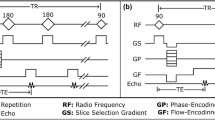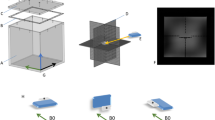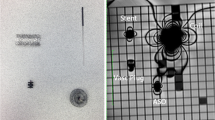Abstract
Titanium (Ti) alloys have been introduced in magnetic resonance (MR) safe implantable medical devices because the susceptibility of Ti is approximately 1/10 that of the Co-Cr-Ni alloy (Elgiloy), which was the previously preferred MR-safe material. The torque applied to metallic materials in an MR imaging (MRI) scanner is commonly believed to increase with the susceptibility of the material. However, a visual inspection showed that the torque applied to Ti alloy cerebral aneurysm clips is comparable with that in the case of those of Elgiloy. In this study, we measured the torque applied to the small test pieces of rods and aneurysm clips quantitatively in a 3-T MRI using an accurate self-developed torque measurement apparatus. The maximum torques of Ti alloy and Elgiloy rod test pieces were comparable as 1.1 and 1.2 µN·m, respectively. The values for Ti alloy aneurysm clips were distinctly higher than the values for those of Elgiloy. These contradictory results of a larger torque for smaller-susceptibility products could be explained by our new theory, which takes into account the crystal susceptibility anisotropy in addition to the conventional torque due to the shape anisotropy.






Similar content being viewed by others
References
Shellock FG. Magnetic resonance safety update 2002: Implants and devices. J Magn Reson Imaging. 2002;16:485–96.
Fujiwara Y, Fujioka H, Watanabe T, Sekiguchi M, Murakami R. A Web-based searchable system to confirm magnetic resonance compatibility of implantable medical devices in Japan: a preliminary study. Radio Phys Technol. 2017;10:340–8.
ASTM. F2052 Standard test method for measurement of magnetically induced displacement force. Annu B ASTM Stand. 2006;i:1–6.
ASTM. F2213 Standard test method for measurement of magnetically induced torque on medical devices in the magnetic resonance environment. Annu B ASTM Stand. 2017;i:1–10.
Ho JC, Shellock FG. Magnetic properties of Ni-Co-Cr-base Elgiloy. J Mater Sci Mater Med. 1999;10:555–60.
Schenck JF. The role of magnetic susceptibility in magnetic resonance imaging: MRI magnetic compatibility of the first and second kinds. Med Phys 1996;23:815–50.
Schaefers G. Testing MR safety and compatibility. IEEE Eng Med Biol Mag. 2008;27:23–7.
Smith MR, Artz NS, Wiens C, Hernando D, Reeder SB. Characterizing the limits of MRI near metallic prostheses. Magn Reson Med. 2015;74:1564–73.
Suyalatu KR, Tsutsumi Y, Doi H, Nomura N, Hanawa T. Effects of phase constitution on magnetic susceptibility and mechanical properties of Zr-rich Zr-Mo alloys. Acta Biomater Acta Materialia Inc. 2011;7:4259–66.
Ebraheim NA, Savolaine ER, Zeiss J, Jackson WT. Titanium hip implants for improved magnetic resonance and computed tomography examinations. Clin Orthop Relat Res. 1992;10:194–8.
Shellock FG, Shellock VJ. Spetzler titanium aneurysm clips: compatibility at MR imaging. Radiology 1998;206:838–41.
Hargreaves BA, Worters PW, Pauly KB, Pauly JM, Koch KM, Gold GE. Metal-induced artifacts in MRI. Am J Roentgenol. 2011;197:547–55.
Reichert M, Ai T, Morelli JN, Nittka M, Attenberger U, Runge VM. Metal artefact reduction in MRI at both 1.5 and 3.0 T using slice encoding for metal artefact correction and view angle tilting. Br J Radiol. 2015;88:20140601.
Kakizawa Y, Seguchi T, Horiuchi T, Hongo K. Cerebral aneurysm clips in the 3-tesla magnetic field. Laboratory investigation. J Neurosurg. 2010;113:859–69.
Fredén Jansson KJ, Håkansson B, Reinfeldt S, Taghavi H, Eeg-Olofsson M. MRI induced torque and demagnetization in retention magnets for a bone conduction implant. IEEE Trans Biomed Eng. 2014;61:1887–93.
Hasegawa M, Miyata K, Abe Y, Ishii T, Ishigami T, Ohtani K, et al. 3-T MRI safety assessments of magnetic dental attachments and castable magnetic alloys. Dentomaxillofacial Radiol 2015;44:1–7.
Van Gelderen P, Mandelkow H, De Zwart JA, Duyn JH. A torque balance measurement of anisotropy of the magnetic susceptibility in white matter. Magn Reson Med. 2015;74:1388–96.
Nyenhuis JA, Park SM, Kamondetdacha R, Amjad A, Shellock FG, Rezai AR. MRI and implanted medical devices: Basic interactions with an emphasis on heating. IEEE Trans Device Mater Reliab. 2005;5:467–79.
Sato M, Ishii Y. Simple and approximate expressions of demagnetizing factors of uniformly magnetized rectangular rod and cylinder. J Appl Phys. 1989;66:983–5.
Dhingra RC, Postle R. 19—the measurement of torque in continuous-filament yarns part II: the effect of yarn tension. J Text Inst. 1974;65:171–81.
Wapler MC, Leupold J, Dragonu I, Von Elverfeld D, Zaitsev M, Wallrabe U. Magnetic properties of materials for MR engineering, micro-MR and beyond. J Magn Reson. 2014;242:233–42.
Cullity BD, Graham CD. Introduction to magnetic materials. 2nd ed. New York, NY: John Wiley and Sons Inc; 2009.
Rokhlenko Y, Gopinadhan M, Osuji CO, Zhang K, O’Hern CS, Larson SR, et al. Magnetic alignment of block copolymer microdomains by intrinsic chain anisotropy. Phys Rev Lett. 2015;115:2–6.
O’Handley RC. Modern magnetic materials: Principles and applications. New York, NY: John Wiley and Sons Inc; 2000.
Acknowledgements
The authors thank Dr Daisaku Ikeda of Mizuho Corporation for providing the materials and the torque measurement apparatus. The authors are deeply appreciative of the reviewer’s constructive comments. This study was supported by Strategic Promotion of Innovative Research and Development (S-Innovation) from the Japan Agency for Medical Research and Development (AMRD).
Author information
Authors and Affiliations
Corresponding author
Ethics declarations
Conflict of interest
The authors declare that they have no conflict of interest.
Additional information
Publisher’s note Springer Nature remains neutral with regard to jurisdictional claims in published maps and institutional affiliations.
Rights and permissions
About this article
Cite this article
Tang, M., Kawahira, S., Nomura, N. et al. Torque property of titanium alloy cerebral aneurysm clips in a magnetic resonance scanner. J Mater Sci: Mater Med 31, 6 (2020). https://doi.org/10.1007/s10856-019-6329-4
Received:
Accepted:
Published:
DOI: https://doi.org/10.1007/s10856-019-6329-4




